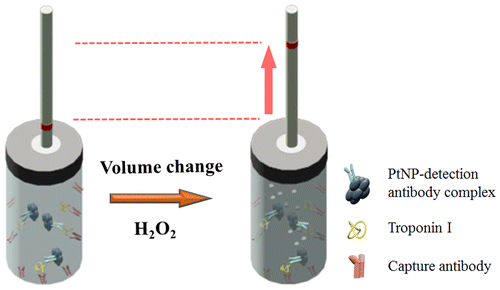Thermometer-like device could help diagnose heart attacks

Diagnosing a heart attack can require multiple tests using expensive equipment. But not everyone has access to such techniques, especially in remote or low-income areas. Now scientists have developed a simple, thermometer-like device that could help doctors diagnose heart attacks with minimal materials and cost. The report on their approach appears in the ACS journal Analytical Chemistry.
Sangmin Jeon and colleagues note that one way to tell whether someone has had a heart attack involves measuring the level of a protein called troponin in the person's blood. The protein's concentration rises when blood is cut off from the heart, and the muscle is damaged. Today, detecting troponin requires bulky, expensive instruments and is often not practical for point-of-care use or in low-income areas. Yet three-quarters of the deaths related to cardiovascular disease occur in low- and middle-income countries. Early diagnosis could help curb these numbers, so Jeon's team set out to make a sensitive, more accessible test.
Inspired by the simplicity of alcohol and mercury thermometers, the researchers created a similarly straightforward way to detect troponin. It involves a few easy steps, a glass vial, specialized nanoparticles, a drop of ink and a skinny tube. When human serum with troponin—even at a minute concentration—is mixed with the nanoparticles and put in the vial, the ink climbs up a protruding tube and can be read with the naked eye, just like a thermometer.
More information: "Facile Detection of Troponin I Using Dendritic Platinum Nanoparticles and Capillary Tube Indicators" Anal. Chem., 2015, 87 (9), pp 5004–5008. DOI: 10.1021/acs.analchem.5b00921
Abstract
A facile method was developed for the detection of Troponin I (TnI) using dendritic platinum nanoparticles and capillary tube indicators. Dendritic platinum nanoparticles were functionalized with TnI antibodies, which were used to capture TnI in human serum. The captured TnI was conjugated to the inner surface of a glass vial, to which a hydrogen peroxide (H2O2) solution was added. After the glass vial was sealed with a screw cap containing a silicon septum, a capillary tube containing a drop of ink was inserted through the septum. The catalytic dissociation of H2O2 to water and oxygen increased the pressure inside the glass vial and raised the ink level in the capillary tube. The ink level increased with the platinum nanoparticle concentration, which is proportional to the TnI concentration. The sensitivity of this assay for TnI in human serum after a 5 min dissociation reaction, detected with the naked eye, was 0.1 ng/mL, which was better than the sensitivity of the conventional colorimetric method using the TMB oxidation reaction under the same experimental conditions. A control experiment using alpha-fetoprotein, interleukin-5, and C-reactive protein revealed that the developed method was highly selective for the detection of TnI.
Journal information: Analytical Chemistry
Provided by American Chemical Society















